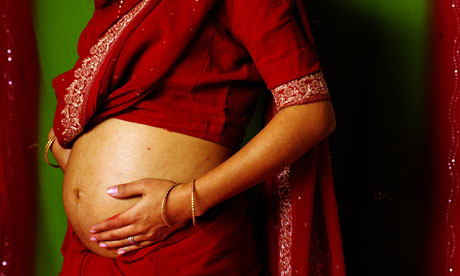
Premila Vaghela, a poor 30-year-old surrogate mother, died last month, while reportedly waiting for a routine examination at a hospital in Ahmedabad. The news was barely covered by the media – after all, she had completed the task she had been contracted for, and the eight-month-old foetus meant for an American "commissioning" parent survived.
In fact Premila was like many other economically marginalised surrogates, who may suffer or even lose their lives while carrying a child, and are quickly forgotten. The highly secretive and largely unregulated baby factories (many of which are dressed up as legitimate IVF clinics) now mushrooming all over India are usually only concerned with the end product: the child.
Even conservative estimates show more than 25,000 children are now being born through surrogates in India every year in an industry worth $2bn. These clinics are not just spreading in big cities but in smaller towns as well. Domestic demand is increasing, but as fertility levels drop elsewhere, at least 50% of these babies are "commissioned" by overseas, mainly western, couples.
Whoever the prospective parents, the pattern is the same: it is only India's desperately poor women who are tempted to rent their wombs. Since the cost of fertility treatment and that of the surrogate is comparatively cheaper in India than in the rest of the world, would-be parents are flooding in, eager to have a child that bears some part of their genetic heritage.
Most of the industry is operating unchecked. India's medical research watchdog drafted regulations more than two years ago, yet they still await presentation in parliament, leaving the surrogates and baby factories open to abuse. And even many of the supposedly well-run clinics do not appear to be transparent in their dealings.
Dr Manish Banker, from the Pulse Women's Hospital, is reported to have said that Premila had come for a check-up. "She suddenly had a convulsion and fell on the floor," he said. "We immediately took her for treatment. Since she was showing signs of distress, we conducted an emergency caesarean section delivery."
The child, who was born a month premature, was admitted to the intensive care unit. Premila was moved to another hospital, which claims she was in a highly critical condition, having suffered a cardiac arrest. Although there's no suggestion that this was the case with Premila, sadly, in many cases the surrogate's life is secondary. It is the baby, for whose birth the hospital is being paid, that is paramount.
Most mothers sign contracts agreeing that even if they are seriously injured during the later stages of pregnancy, or suffer any life-threatening illness, they will be "sustained with life-support equipment" to protect the foetus. Further, they usually agree to assume all medical, financial and psychological risks – releasing the genetic parents, their lawyers, the doctors and all other professionals from all liabilities.
Besides, in tragic cases like Premila's, the hospital would have quickly paid out the money owed for a 'successful' birth, so the family would be unlikely to complain. Premila herself had gone in for the surrogacy to provide her own two children a better life. In a country where thousands of women die every year in normal childbirths, who would complain about the death of one surrogate?
Anindita Majumdar, who is researching surrogacy for her doctorate, says she is personally distressed by how easily the "sheer horror" of it all is being swept away by the money paid out to the surrogates. There are many grey areas - and she fears that even the draft legislation, when it is passed, will favour the medical community over the rights of the surrogate.
Already many malpractices, such as implantation of more than four embryos in the surrogate's womb, as well as invasive "foetal reduction" frowned on the world over, are being followed. Often women undergo caesareans so the time of birth suits the commissioning parents.
While researching my novel I found that women are more than willing to undergo the risks. They feel that by renting their wombs (perhaps the only asset they possess), they can make enough money to look after their families. And indeed, many have earned enough to build small homes for their families, and buy some security for their children's schooling. One surrogate told me she wanted her daughter to receive a proper education and speak English just like I did. She was only 21, and carrying twins for a commissioning couple – but she was already planning her next three surrogacies.
One woman, according to another researcher, had over 20 cycles of hormonal injections. Since each child is often born through caeserean section (so that the birth coincides with the arrival of the commissioning parents) the health of the surrogate is likely to suffer with each operation.
I found that medical practitioners involved in it are rarely troubled about the fate of the women whose normal maternal cycles have been disrupted. As in Premila's case, they seem to be only interested in delivering the end-product: a child.
If India doesn't pass the regulatory bill soon, the international community should pressurise it to do so. This is now a global industry so requires an international law and a global fertility body to regulate it. Otherwise, it is likely that most of the unhealthy practices prevailing will go underground – and the fog of secrecy over the industry will become more dense.
• Follow Comment is free on Twitter @commentisfree

